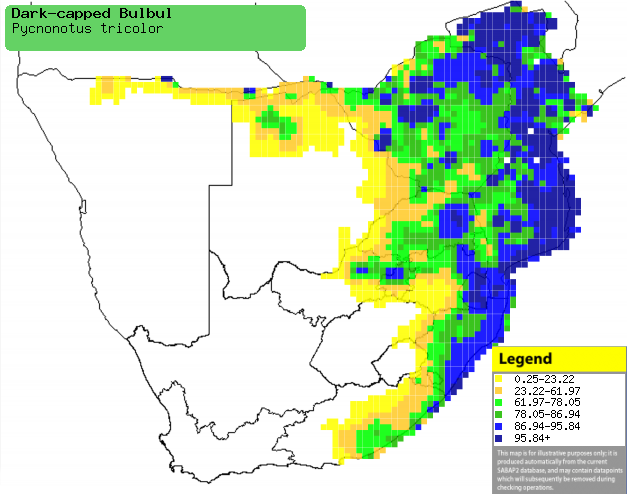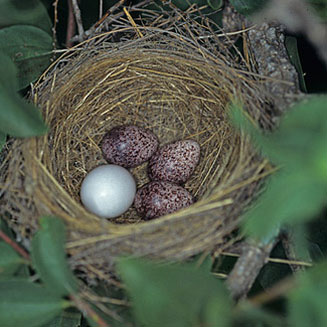|
Pycnonotus tricolor
(Dark-capped bulbul, Black-eyed bulbul)
[= Pycnonotus barbatus]
Swartoogtiptol [Afrikaans]; Ikhwebula [Xhosa]; iPhothwe,
iPogota [Zulu]; Mburukutji (generic term for bulbul) [Kwangali];
Hlakahlotoana (also applied to African red-eyed bulbul) [South Sotho];
Rankgwethe [North Sotho]; Bwoto, Chigwenhure, Mugweture [Shona];
Ligibholo [Swazi]; Bhokota [Tsonga]; Rramorutiakolê [Tswana]; Grauwe
buulbuul [Dutch]; Bulbul tricolore [French]; Gelbsteißbülbül,
Graubülbül [German]; Tuta-negra [Portuguese]
Life
> Eukaryotes >
Opisthokonta
> Metazoa (animals) >
Bilateria >
Deuterostomia > Chordata >
Craniata > Vertebrata (vertebrates) > Gnathostomata (jawed
vertebrates) > Teleostomi (teleost fish) > Osteichthyes (bony fish) > Class:
Sarcopterygii (lobe-finned
fish) > Stegocephalia (terrestrial
vertebrates) > Tetrapoda
(four-legged vertebrates) > Reptiliomorpha > Amniota >
Reptilia (reptiles) >
Romeriida > Diapsida > Archosauromorpha > Archosauria >
Dinosauria
(dinosaurs) > Saurischia > Theropoda (bipedal predatory dinosaurs) >
Coelurosauria > Maniraptora > Aves
(birds) > Order: Passeriformes
> Family: Pycnonotidae
Distribution and habitat
It occurs across much of sub-Saharan Africa, from Chad to
Ethiopia south to southern Africa. Here it is common to abundant across
Zimbabwe, Mozambique, Northern Botswana, the Caprivi Strip, the Limpopo
Province, Mpumalanga, KwaZulu-Natal and the Eastern Cape. It can occupy any
habitat with adequate supply of fruiting trees and bushes, absent only from
dense woodland or grassland with few bushes. It is particularly common in
gardens, plantations and parks in and around human settlements.
|
 |
|
Distribution of Dark-capped bulbul in southern Africa,
based on statistical smoothing of the records from first SA Bird Atlas
Project (©
Animal Demography unit, University of
Cape Town; smoothing by Birgit Erni and Francesca Little). Colours range
from dark blue (most common) through to yellow (least common).
See here for the latest distribution
from the SABAP2. |
Brood parasites
It has been recorded as host of the
Jacobin cuckoo.
Food
It eats a range of fruit, petals, nectar, seeds and
arthropods, foraging in groups and using a wide variety of techniques. These
include plucking fruit from trees and bushes, probing the flowers of Aloe
for nectar, hawking flying insects, hunting for spiders on buildings and
picking up fallen fruit. The following food items have been recorded
in its diet:
- Fruit
- Seeds of Cassia plants
- Nectar
- Aloe
- Grevillea (silky oaks)
- Sideroxylon inerme (White milkwood)
- Petals of Aloe ferox (Bitter aloe)
- Insects
- Spiders
Breeding
- Monogamous and territorial, with males defending their territories against
other males by lowering their wings and head and chasing the intruder. If
the confrontation escalates into a fight, the males viciously peck and
scratch each other, sometimes interlocking their claws in mid flight and
falling to the ground.
- The female builds the nest, which is a tidy and well-built cup built of
rootlets, dry grass and twigs with an outer layer of spider web, and lined
with finer plant material. it is typically placed on a branch or slung
between a few twigs, generally concealed towards the edge of the canopy,
often found in suburban gardens.
 |
|
|
Dark-capped bulbul nest with a white egg laid by a
Jacobin cuckoo, Sericea farm, South Africa. [photo Warwick Tarboton ©] |
|
- Egg-laying season is from July-April, peaking around September-December.
- It lays 2-3 eggs, which are incubated by the female for about 12-15
days, while the male regularly brings her food at the nest.
- The chicks are brooded almost constantly by the female at first, but
thereafter both adults leave the nest repeatedly in search of food. The
young stay in the nest for about 11-16 days, leaving before they can fly. At
first they remain huddled together in the tree where the nest is placed, but
soon they join their parents in foraging trips.
Threats
Not threatened.
References
-
Hockey PAR, Dean WRJ and Ryan PG 2005. Roberts
- Birds of southern Africa, VIIth ed. The Trustees of the John Voelcker
Bird Book Fund, Cape Town.
-
Harrison, J.A., Allan, D.G., Underhill, L.G., Herremans, M.,
Tree. A.J., Parker, V. & Brown, C.J. (eds). 1997. The atlas of southern
African birds. Vol. 2: Passerines. BirdLife South Africa, Johannesburg.
|
